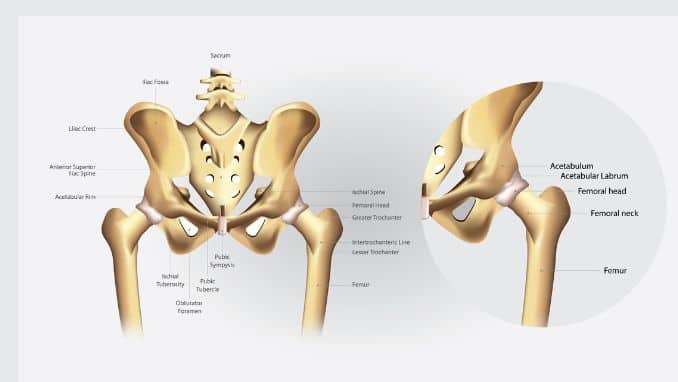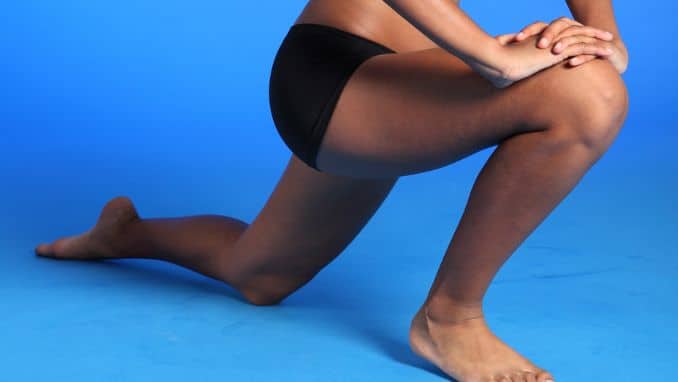
The snapping hip syndrome refers to the condition in which you feel a snapping or popping sensation in your hip when you move it, such as walking or getting up from a chair. This occurs when a muscle or tendon moves over a bony part of your hip. Generally, snapping hip syndrome is not painful and dangerous, although it can be bothersome. And in some cases, it can lead to bursitis or inflammation of the fluid-filled sac that cushions the hip joint.
Snapping Hip Syndrome: Anatomy Of The Hip Joint
The hip joint is formed by two bones, the head of the femur (thighbone) and the acetabulum in the pelvis. The acetabulum is ringed by a strong fibrocartilage called the labrum that helps hold the head of the thigh bone and provides stability to the joint.
The hip joint also has ligaments that surround it and helps in holding it together. Over these ligaments are tendons that attach the bone to the muscles in the buttocks, thighs, and pelvis to the bones. Bursae, fluid-filled sacs, are located on the surface of the bones to provide cushioning and help prevent harsh gliding of the bone to the bone during movement.
How Does Snapping Hip Syndrome Occur?
Snapping hips can happen in different areas of the hips. It can occur outside, in front, at the back, and because of cartilage problems.
The most common site of snapping hip syndrome occurs on the outer side of the hip joint. In a normal plane, the iliotibial band is located behind the trochanter. But when the hips are flexed, the iliotibial band moves over the trochanter to go to the front of it. Most of the iliotibial band is tight, and because the trochanter slightly sticks out, it creates a snapping sensation or popping sound you hear.
Another tendon that causes a snapping hip is the rectus femoris tendon. It runs from the front of the thigh up to the pelvis. When the hips are flexed, this tendon shifts across the head of the thigh bone, and when you straighten your hips, it moves back to the side of the thigh bone. The back-and-forth motion from this causes the snapping hip. Aside from this, the iliopsoas tendon can catch over the bony prominences at the front of the pelvis bone.
Meanwhile, although uncommon, the hamstring tendon located at the back of the hip can also cause a snapping hip. This tendon attaches to the ischial tuberosity. When this tendon moves across the ischial tuberosity, it may catch it and cause a snapping sensation in the buttocks area.
Lastly, problems with the labrum that rings the acetabulum in the pelvis can be torn and cause snapping hips. Damaged cartilage may loosen and float around the joint, which causes the hip to catch or lock upon movement. Symptoms of this can cause more pain in the groin than in the hip in typical snapping hip syndrome.
Snapping Hip Syndrome Treatment
Treatment for snapping hip syndrome usually depends on what causes it. However, initial treatment includes rest, physical therapy, and activity modifications.
Snapping Hip Syndrome Exercises
Exercises that stretch and strengthen the muscles around your hip are recommended.
1. Snapping Hip Syndrome Exercises: Iliotibial Band Stretch
Stand beside a wall with the leg with the affected hip close to the wall. You can also hold onto a chair or table for support. Now stand on the leg with the affected hip and cross your opposite leg in front of your affected leg. Then lean your affected hip to the side of your body and against the wall. And lean away from your affected hip until you feel a gentle stretch. Hold this position for 30 seconds, then relax and return to the starting position. Complete 3-5 repetitions. Switch sides.
2. Snapping Hip Syndrome Exercises: Kneeling Hip Flexor Stretch
Place your hands on your hips. Bend your unaffected leg in front of you with your feet flat on the floor and kneel on your affected leg; place a towel under this to avoid discomfort. While keeping your back straight, slowly push your hips forward until you feel a gentle stretch in the upper thigh of your affected leg. Hold this position for 30 seconds, then relax and return to the starting position. Complete 3-5 repetitions. Switch sides.
3. Snapping Hip Syndrome Exercises: Piriformis Stretch
Lie on your back with your knees bent and feet flat on the floor. Now place the ankle of your affected leg on your opposite thigh. Then place your hands on the back of your unaffected leg. Gently pull your leg towards your chest until you feel a gentle stretch in the buttock and hip of your affected leg. Hold this position for 30 seconds, then relax and return to the starting position. Complete 3-5 repetitions. Switch sides.
4. Supine Hamstring Stretch
Lie on your back on the floor with your legs straight. Now hold the back thigh of your affected leg for support, or you can put a towel on the balls of your feet and hold it on the end of both sides. Then raise your leg, ensuring you don’t bend your knee until you feel a gentle stretch on the back of your thigh. Hold this position for 30 seconds, then relax and return to the starting position. Complete 3-5 repetitions. Switch sides.
5. Bridging
Lie on your back on the floor with your knees bent, your feet flat on the floor, and your arms on your side. Now push on your feet to raise your hips off the floor and squeeze your buttocks until your shoulders, hips, and knees are aligned. Hold this position for 7 seconds before returning to the starting position. Complete 10 repetitions.
Conclusion
Snapping Hip Syndrome can be cured with conservative treatment over time; however, if it doesn’t, surgery is recommended. It is always best to consult a doctor to receive the best treatment. This includes hip arthroscopy, open procedure, and others.







